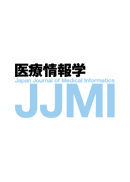Volume 42, Issue 5
Displaying 1-6 of 6 articles from this issue
- |<
- <
- 1
- >
- >|
Feature: The 26th Annual Meeting of Japan for Medical Informatics
Conference Organized Session 1
-
Article type: Conference Organized Session 1
2023Volume 42Issue 5 Pages 191-195
Published: March 03, 2023
Released on J-STAGE: March 14, 2024
Download PDF (784K)
Conference Organized Session 2
-
Article type: Conference Organized Session 2
2023Volume 42Issue 5 Pages 197-201
Published: March 03, 2023
Released on J-STAGE: March 14, 2024
Download PDF (784K)
Conference Organized Session 3
-
Article type: Conference Organized Session 3
2023Volume 42Issue 5 Pages 203-204
Published: March 03, 2023
Released on J-STAGE: March 14, 2024
Download PDF (776K)
Conference Organized Session 4
-
Article type: Conference Organized Session 4
2023Volume 42Issue 5 Pages 205-210
Published: March 03, 2023
Released on J-STAGE: March 14, 2024
Download PDF (788K)
Proceeding of the Spring Meeting on Medical Informatics
-
Article type: Proceeding of the Spring Meeting on Medical Informatics
2023Volume 42Issue 5 Pages 211-215
Published: March 03, 2023
Released on J-STAGE: March 14, 2024
Download PDF (813K) -
Article type: Proceeding of the Spring Meeting on Medical Informatics
2023Volume 42Issue 5 Pages 217-225
Published: March 03, 2023
Released on J-STAGE: March 14, 2024
Download PDF (949K)
- |<
- <
- 1
- >
- >|
